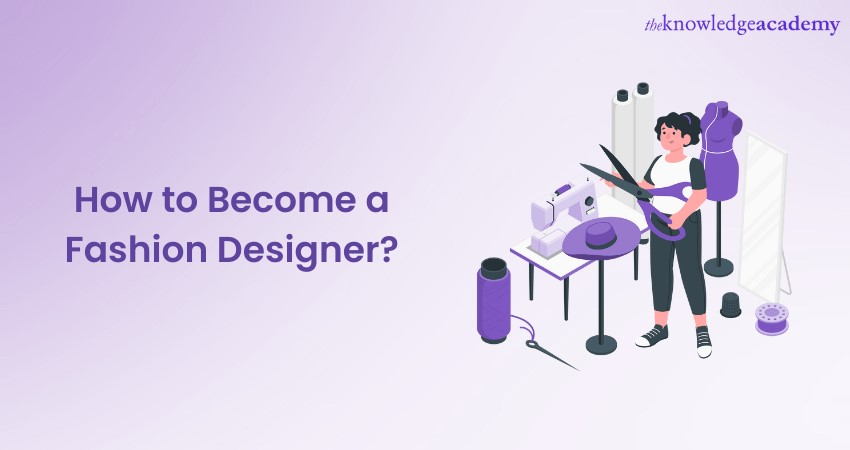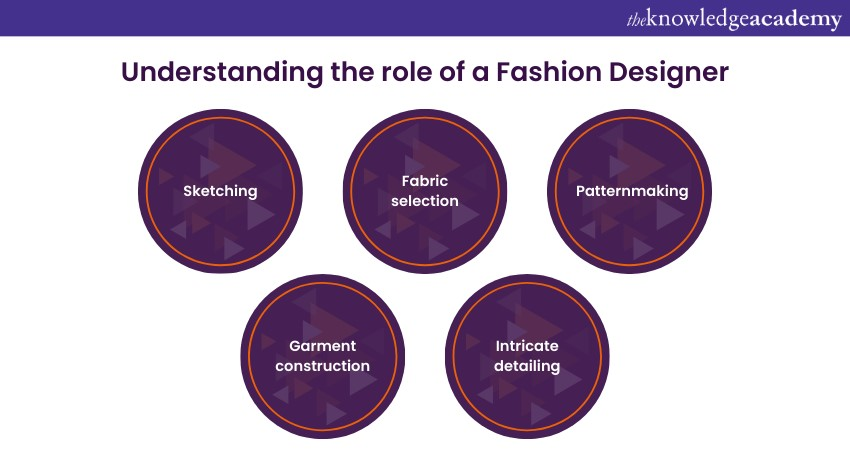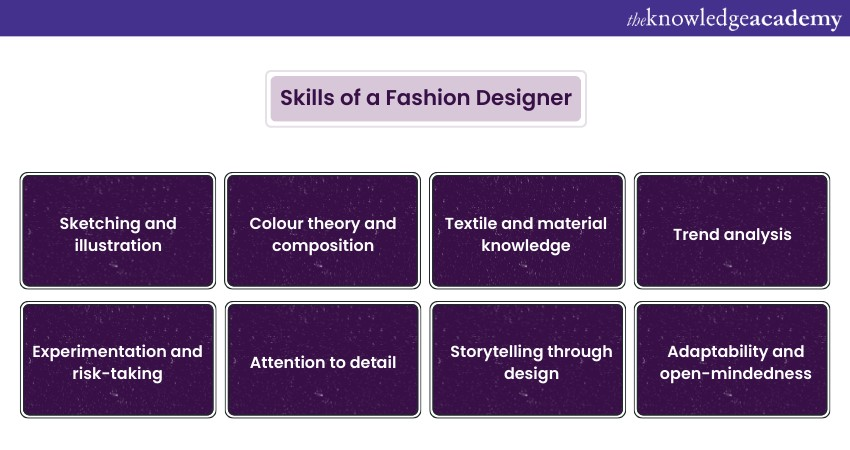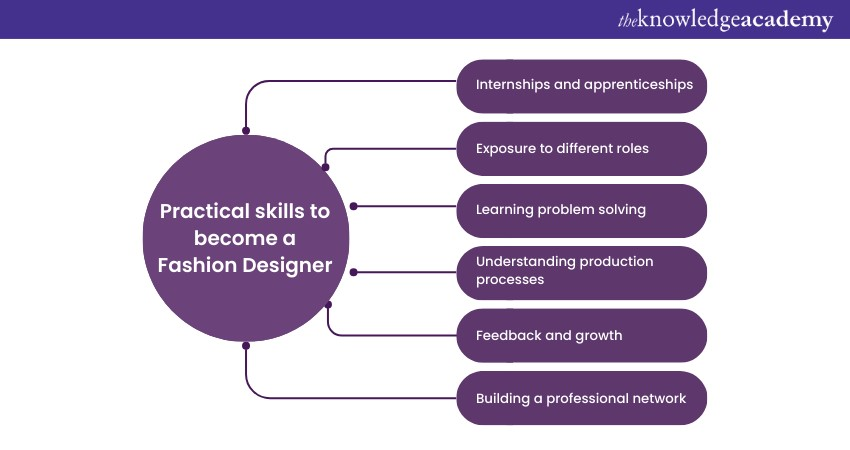We may not have the course you’re looking for. If you enquire or give us a call on +32 35001305 and speak to our training experts, we may still be able to help with your training requirements.
Training Outcomes Within Your Budget!
We ensure quality, budget-alignment, and timely delivery by our expert instructors.

Are you thinking about How to Become a Fashion Designer? It is an industry that thrives with passionate people with the introduction of new designs, which never fails to disappoint. Becoming a part of such a creative field can be a little daunting at first, but with sufficient preparation, it is an achievable goal.
According to Glassdoor, the average annual salary of a Fashion Designer ranges from £25,000 - £62,000. This implies that the Fashion industry is ever-evolving, requiring skilled professionals. However, if you are new to this world, it’s time to learn how you can build a career as a Fashion Designer. So, read this blog to learn How to Become a Fashion Designer. Also, explore the intricacies of this industry that will help you take a step closer towards your dream job.
Table of Contents
1) Understanding the role of a Fashion Designer
2) How to Become a Fashion Designer: Step-by-step guide
a) Develop your creative skills
b) Build a strong educational foundation
c) Gain practical experience
d) Create a stellar portfolio
e) Network and connect
f) Stay updated with industry trends
3) Conclusion
Understanding the role of a Fashion Designer
To begin your journey of becoming a Fashion Designer, it's imperative to grasp the multifaceted role that awaits you in the world of Fashion. Beyond the glamour of runway shows and magazine spreads, a Fashion Designer's responsibilities encompass a broad spectrum of tasks that contribute to creating and disseminating trends, styles, and artistic expressions.

A Fashion Designer is more than just a creative mind; they are the architects behind every garment, ensemble, and collection that graces the Fashion landscape. From conceptualisation to execution, Designers are responsible for translating their artistic visions into tangible, wearable pieces. This involves sketching, fabric selection, patternmaking, garment construction, and intricate detailing.
Navigating the creative process
Understanding the creative process is essential. Fashion Designers draw inspiration from myriad sources, be it nature, culture, history, or personal experiences. They transform abstract ideas into concrete designs through sketching, mood boards, and fabric swatches. This process demands a keen eye for aesthetics, an innovative approach, and the ability to foresee how a design will interact with different materials.
Incorporating practicality and functionality
While artistic expression is vital, Fashion Designers must also consider their creations' practical aspects. Garments need to be not only visually appealing but also functional and comfortable. Balancing creativity with wearability is a hallmark of successful Designers, ensuring their creations resonate with avant-garde Fashion enthusiasts and everyday consumers.
Understanding market trends and consumer preferences
Fashion Design is intrinsically linked to the market. To thrive in this dynamic landscape, Designers must possess a deep understanding of current and future trends, as well as the evolving preferences of their target audience. This involves extensive research into consumer behaviour, Fashion forecasting, and staying attuned to societal shifts influencing Fashion choices.
Collaboration and teamwork
Fashion Design is rarely a solo endeavour. Designers collaborate with a team that includes Patternmakers, Sewists, Stylists, and Marketing professionals. Effective communication and teamwork are crucial to ensure the Designer's vision is realised cohesively and accurately.
Cultural and social awareness
Fashion Designers are culturally sensitive and socially aware in today's globalised world. They have the power to influence perceptions and challenge norms through their creations. Therefore, it is crucial to understand the cultural significance of designs and ensure that they do not perpetuate stereotypes or offend sensibilities.
Gain knowledge about all the essential tools and processes to create a Fashion collection - sign up for our Fashion Designing Training now!
How to Become a Fashion Designer: Step by step guide
Becoming a Fashion Designer is a dream for many creative individuals; let’s have a look at this step-by-step guide to pursue this dream:
Develop your creative skills
Aspiring Fashion Designers must cultivate rich creative skills to breathe life into their visions. Mastering these skills hones their artistic abilities and equips them to stand out in the competitive Fashion world. Some of these skills include the following:

a) Sketching and illustration: Proficiency in sketching is fundamental. Learn to translate your ideas onto paper, capturing the essence of your designs through detailed illustrations. Practice different techniques and experiment with diverse styles to broaden your creative repertoire.
b) Colour theory and composition: Understanding the interplay of colours is essential for creating visually captivating designs. Learn about colour theory, harmonious palettes, and how different shades evoke emotions. Compose your plans in a way that draws attention and conveys your intended message.
c) Textile and material knowledge: A deep understanding of fabrics and materials is crucial. So, familiarise yourself with various textiles, their characteristics, and how they drape, flow, or hold the structure. This knowledge can influence your design choices and enhance the tactile experience of your creations.
d) Trend analysis: Stay abreast of historical and contemporary Fashion trends. Analyse how trends emerge, evolve, and impact consumer preferences. This insight lets you incorporate timely elements into your designs while maintaining your unique signature.
e) Experimentation and risk-taking: Creativity thrives when you step outside your comfort zone. Thus, experiment with unconventional materials, silhouettes, and techniques. Embrace failure as a learning opportunity, as some of the most innovative designs stem from taking calculated risks.
f) Attention to detail: The magic of Fashion often resides in intricate details. Train yourself to notice and perfect every element of your designs, from buttons to stitching to embellishments. These nuances elevate your work from ordinary to extraordinary.
g) Storytelling through design: Develop the ability to infuse your creations with narratives and emotions. Your designs should look beautiful and convey a message, provoke thought, or evoke a feeling.
h) Adaptability and open-mindedness: Be open to learning new techniques, exploring different cultures, and drawing inspiration from unexpected sources. This willingness to evolve can keep your designs fresh and relevant.
Build a strong educational foundation
The next step in learning How to be a Fashion Designer involves learning about the educational requirements. Formal education equips you with essential technical skills and provides a broader perspective on the Fashion industry and its nuances. Here's how you can build a strong educational background:
a) Sign up for Fashion Design programs: Consider joining accredited Fashion Design programs. These courses provide a structured curriculum that covers everything from Design principles to garment construction. Look for institutions with experienced faculty and access to modern design facilities.
b) Study Design principles and techniques: Fashion Design education focuses on the foundational principles of Design, including proportion, balance, and harmony. You can learn various Fashion Design techniques, patternmaking, draping, and sewing skills that form the bedrock of your craft.
c) Gain exposure to industry software: Modern Fashion Design involves using digital tools. Learning software like Adobe Illustrator or CAD (Computer-Aided Design) allows you to translate your sketches into digital designs and collaborate effectively with other professionals in the industry.
d) Explore related subjects: While specialising in Fashion Design is crucial, also focus on related topics like textiles, Fashion history, and trend analysis. These subjects broaden your understanding of the Fashion ecosystem and provide context for your designs.
e) Participate in workshops and seminars: Supplement your formal education with workshops, seminars, and guest lectures. These opportunities expose you to industry experts, current trends, and real-world insights that textbooks might need to cover.
Gain knowledge and understanding of an interest - sign up for our Hobbies & Interests Training now!
Gain practical experience
Practical experience is the bridge between theory and mastery in the realm of Fashion Design. It offers invaluable insights, real-world application of skills, and a firsthand understanding of the industry's inner workings. Here's why gaining practical experience is crucial in becoming a successful Fashion Designer:

a) Hands-on exposure: Securing internships or externships with established Designers, Fashion houses, or production companies provides hands-on exposure. You can witness the Design process from conception to execution, gaining insights into how designs evolve and produce garments.
b) Exposure to different roles: Practical experience exposes you to various roles within the industry. You might work with Patternmakers, Sewists, Stylists, and Marketing teams. Understanding these roles enhances your collaboration skills and broadens your perspective.
c) Learning problem solving: Real-world scenarios often present unexpected challenges. Overcoming these challenges sharpens your problem-solving skills and teaches you to adapt and innovate on the fly.
d) Understanding production processes: Hands-on experience helps you understand the intricacies of garment production. Witnessing the transition from raw Design to finished product teaches you about materials, construction techniques, and quality control.
e) Feedback and growth: Working alongside experienced professionals exposes you to constructive criticism. Feedback assists in identifying areas for improvement and provides direction for refining Fashion Design skills.
f) Building a professional network: Practical experience introduces you to industry insiders, mentors, and potential collaborators. Building relationships during internships or apprenticeships can lead to future job opportunities and partnerships.
g) Gaining confidence: Seeing your designs come to life and contributing to a tangible end product boosts your confidence as a Fashion Designer. Practical experience validates your skills and prepares you for the challenges of the Fashion industry.
Create a stellar portfolio
A well-crafted portfolio is your artistic showcase, the visual narrative of your journey as a Fashion Designer. It serves as your passport to internships, job interviews, and collaborations. Here's how to create a portfolio that leaves a lasting impression:
a) Variety is key: Include diverse designs that highlight your versatility. Show proficiency in different styles, techniques, and garment types, demonstrating your ability to adapt and innovate.
b) Showcase progression: Document your growth as a Fashion Designer by including works from different journey stages. This progression reflects your evolving skills and commitment to improvement.
c) Quality over quantity: Choose quality over quantity. Select a curated collection of your best work to showcase depth and refinement rather than overwhelming it with sheer volume.
d) Contextualise your designs: Provide context for each piece. Explain your inspiration, Design process, and the story behind the creation. This narrative adds depth and resonates with potential employers or clients.
e) Highlight technical skills: Showcase your technical capabilities by including sketches, pattern drafts, and detailed construction plans. This demonstrates your understanding of the entire Design process.
f) Digital and print versions: Create digital and print versions of your portfolio. A digital portfolio allows for easy sharing online, while a physical portfolio adds a tactile element for in-person presentations.
g) Consider cohesiveness: While variety is necessary, ensure a sense of cohesiveness. Choose a consistent colour palette, layout, and overall aesthetic that reflects your style.
h) Regular updates: Keep your portfolio updated as you create new designs and gain more experience. Regular updates reflect your commitment to growth and showcase your latest accomplishments.
Want to elevate your makeup skills? Then sign up now for our course on Make Up - Eyebrows and Eyelashes!
Network and connect
Last step in learning How to Become a Fashion Designer is knowing how to build a strong network. In the Fashion industry, networking is as essential as the design itself. Building meaningful connections opens doors to opportunities, collaborations, and exposure. Here's how to effectively network and connect within the Fashion world:
a) Attend industry events: Participate in Fashion shows, exhibitions, seminars, and workshops. These events offer platforms to meet fellow Designers, professionals, and potential mentors.
b) Online presence: Create a strong online presence on Instagram, LinkedIn, and Fashion forums. Share your work and insights, and engage with peers and influencers in the industry.
c) Collaborations: Collaborate with other Designers, photographers, models, and stylists. Working together expands your creative horizons and introduces you to their networks.
d) Personal branding: Craft a unique personal brand representing your style and values. A consistent and distinctive brand identity helps you stand out in a competitive field.
e) Reaching out: Don't hesitate to reach out to professionals you admire. Send polite emails, attend their talks, and express genuine interest in their work. Networking is often about taking the initiative.
f) Elevator pitch: Build a concise and compelling elevator pitch about yourself and your Design philosophy. This helps you introduce yourself confidently in networking situations.
Stay updated with industry trends
Remaining attuned to the ever-evolving Fashion landscape is vital to a Fashion Designer's journey. Staying updated with industry trends ensures your designs are relevant and in sync with your target audience. Here's how to effectively stay on top of the latest trends:
a) Fashion magazines and publications: Subscribe to Fashion magazines and online publications. These sources offer insights into runway shows, Designer interviews, and emerging trends.
b) Trend forecasting reports: Study trend forecasting reports from reputable agencies. These reports provide insights into upcoming colours, fabrics, styles, and consumer preferences.
c) Social media and influencers: Follow Fashion influencers, Designers, and brands on platforms like Instagram and Pinterest. Social media offers real-time access to trends and inspirations.
d) Attend Fashion weeks: Attend local or international Fashion weeks whenever possible. The latest collections are showcased at these events and set the tone for upcoming trends.
e) Explore retail spaces: Visit boutiques, department stores, and pop-up shops to observe what's currently in demand and how consumer preferences are evolving.
f) Online Fashion communities: Join online forums, groups, and communities dedicated to Fashion. Engage in discussions, share ideas, and learn from fellow enthusiasts.
g) Explore street style: Street style can be a potent source of inspiration. Observe how people incorporate trends into their everyday wardrobes for practical insights.
h) Cross-industry inspiration: Look beyond Fashion for inspiration. Art, architecture, nature, and technology can all influence design trends.
i) Continuous learning: Consider taking online courses or workshops on trend analysis and Fashion forecasting. These educational opportunities refine your skills in recognising and interpreting trends.
Conclusion
In Fashion, the journey to becoming a Fashion Designer is an artful blend of creativity, education, and dedication. By embracing the steps outlined in this blog on How to Become a Fashion Designer, you can embark on a transformative path where passion meets the profession.
Want to elevate your makeup skills? Then sign up for our Make Up - Eyebrows and Eyelashes Course!
Frequently Asked Questions
Upcoming Business Skills Resources Batches & Dates
Date
 Fashion Designing Training
Fashion Designing Training
Fri 7th Feb 2025
Fri 4th Apr 2025
Fri 6th Jun 2025
Fri 8th Aug 2025
Fri 3rd Oct 2025
Fri 5th Dec 2025







 Top Rated Course
Top Rated Course



 If you wish to make any changes to your course, please
If you wish to make any changes to your course, please


